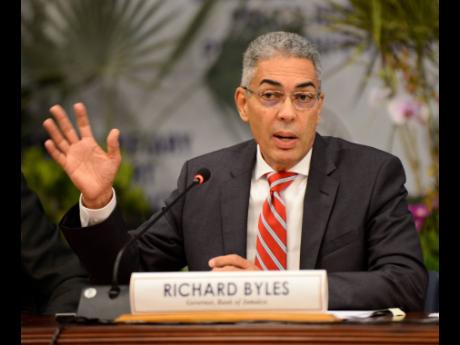BOJ lowers inflation outlook as missed target triggers FinMin report
A mere month into its new independent status and with its core mandate being inflation control, a clause in the newly amended Bank of Jamaica (BOJ) Act has been triggered, requiring the central bank governor to provide the Government with an account outlining the reasons for the four to six per cent inflation target having been missed.
The year-to-date inflation out-turn to April was 3.8 per cent, missing the mandated floor of 4.0 per cent by 20 basis points.
Speaking at the central bank's quarterly press briefing in Kingston on Friday, BOJ Governor Richard Byles said the deceleration of inflation from 5.2 per cent in March to 3.8 per cent in April was due mainly to a reduction in electricity rates, which is among the weightiest items influencing movement in the Consumer Price Index, CPI.
Core inflation, which strips out fuel and agricultural food prices, was 5.5 per cent, up from 5.3 per cent in March, reflecting the influence of higher processed food prices, according to the BOJ governor.
The central bank's report, he said, will be provided to Finance Minister Dr Nigel Clarke within 60 days. In April the Government accepted the central bank's recommendation for the inflation target to be held at the 4 to 6 per cent for the next three financial years.
The central bank is also drawing on what it says is its “fairly successful” history of guiding inflation within the agreed band.
In the last 40 months to April, annualised inflation kept within the target 38 times, overshot the upper bound on two occasions and fell below the lower limit 15 times, Byles reported.
Meanwhile, the central bank has lowered its near-term inflation outlook covering the remainder of the year. It now projects inflation to be:
• June quarter: 3.5% to 4.5%
• September quarter: 4.5% to 5.5% and
• December quarter: 3.5% to 4.5%
This, Byles said, is predicated on agricultural price rises being smaller than previously anticipated given the outlook for better weather conditions. Higher processed food prices in recent times, driven by higher imported commodity prices and costlier shipping, have been taken into consideration, he noted.
Following a review of the economy by the newly created BOJ Monetary Policy Committee on May 14 and 17, the BOJ expects inflation for the next two years to remain within the target range, and is projected to average 4.8 per cent over the period. This outlook does not expect oil and grain prices to rise significantly beyond current levels. As a result, the monetary authorities are not expecting processed food and domestic transport cost to be impacted by any inflationary pressure, keeping those prices more or less at current levels.
The longer term outlook also builds into inflation performance expectations of lower prices for domestic farm produce. Core inflation, however, is expected to be pushed up moderately, in the BOJ's estimation, by growth in gross domestic product and some imported inflation.
The central bank is continuing to keep an eye on risks to inflation that could burst ceiling, pushed up by a stronger than anticipated impact of international commodity prices on local prices. At the same time, significantly lower farm prices could affect the lower limit of the target, Byles noted.
The Monetary Policy Committee, created by the amended law governing the central bank, announced on Thursday that it would be holding policy interest rate at 0.5 per cent. Byles said this was based on the MPC's assessment that inflation will continue to trend within the inflation target. The low policy rate posture, he said, would be held as long as there are no threats to inflation overshooting the upper target.
The bank is also pointing to green shoots in the economy, indicative of the resumption of economic growth.
“We are beginning to see signs of incremental improvement in economic activity including employment, inflows into the foreign exchange market, the balance of payments, our reserves and inflation,” Byles said.
Foreign exchange supplies are also sufficient to meet demand, the BOJ governor reported.
Despite the signs of recovery in the economy, buttressed by a smaller contraction in the December 2020 quarter relative to the previous two periods, BOJ maintained its outlook for the fiscal year. It projects that real GDP contracted between 10 and 12 per cent for the fiscal year ending March 2021.
A partial rebound of five per cent, the BOJ governor said, is expected for fiscal 2022, and could rise as much as eight per cent on the back of a stronger recovery in tourism.
Despite having a positive near-term outlook, Byles cautioned that the Jamaican economy “was not yet out of the woods”, given continuing uncertainties about the duration of the pandemic.
Correction: This story has been updated to reflect that the inflation target was missed by 20 basis points and not 200 basis points.

